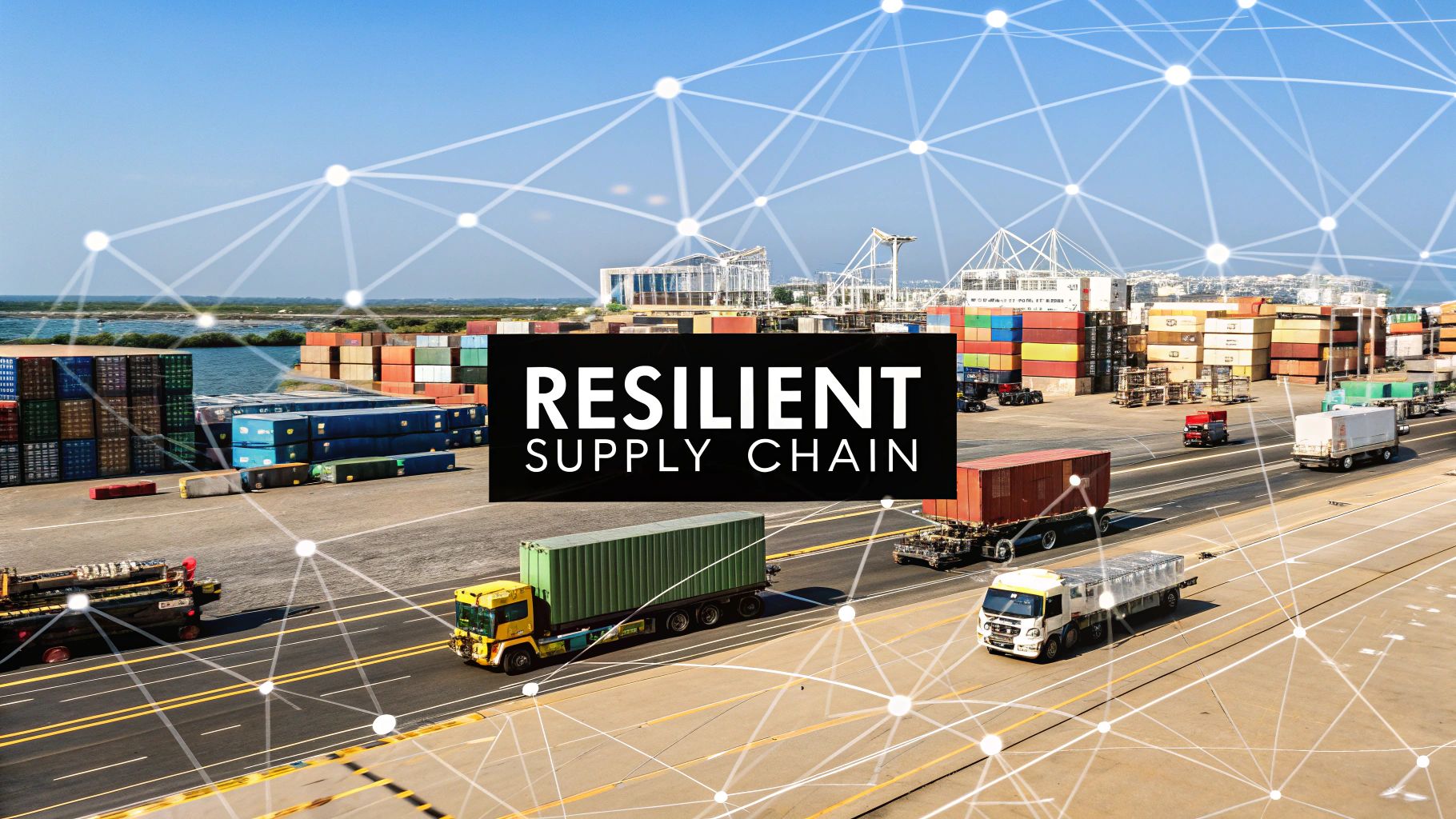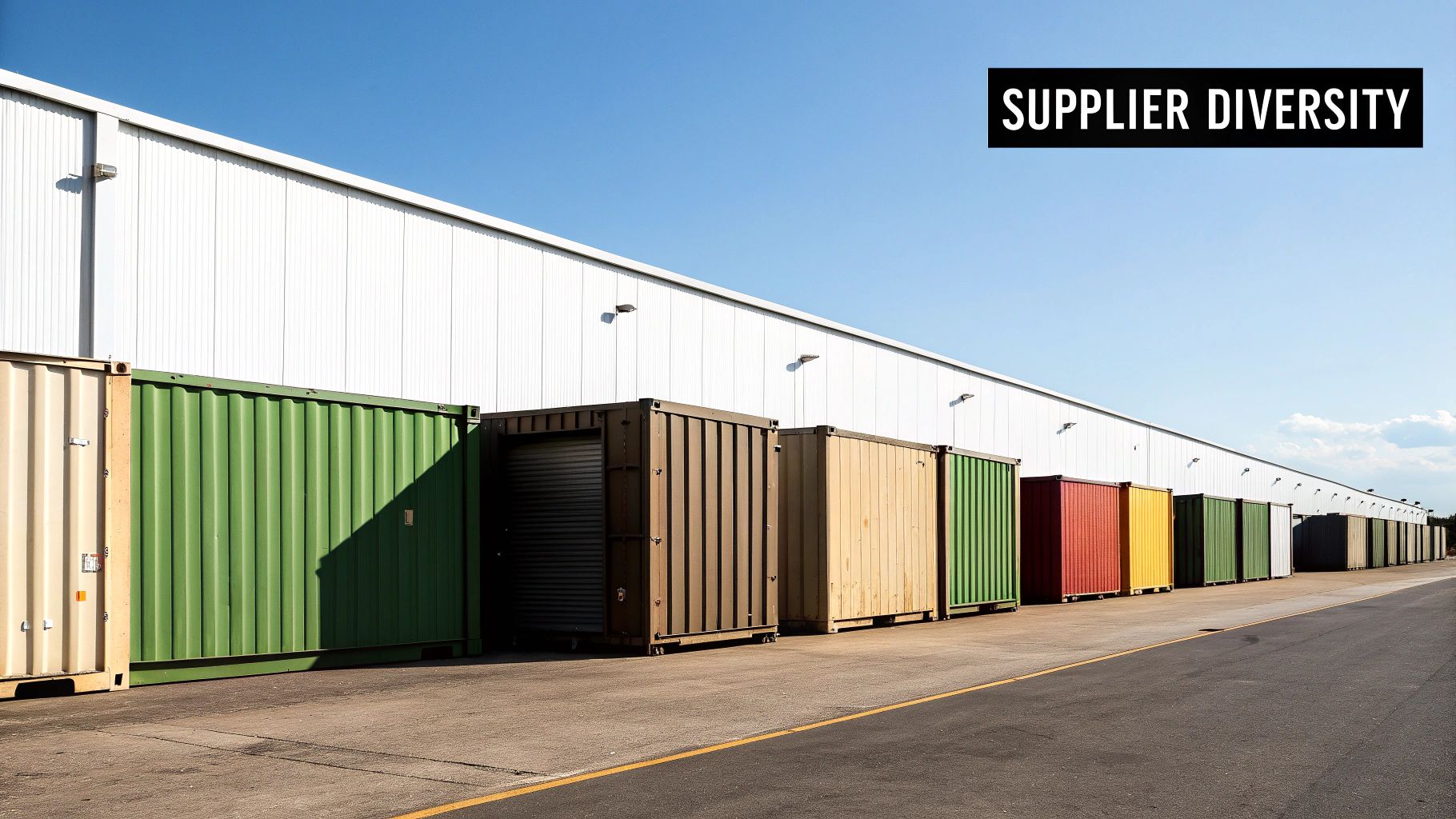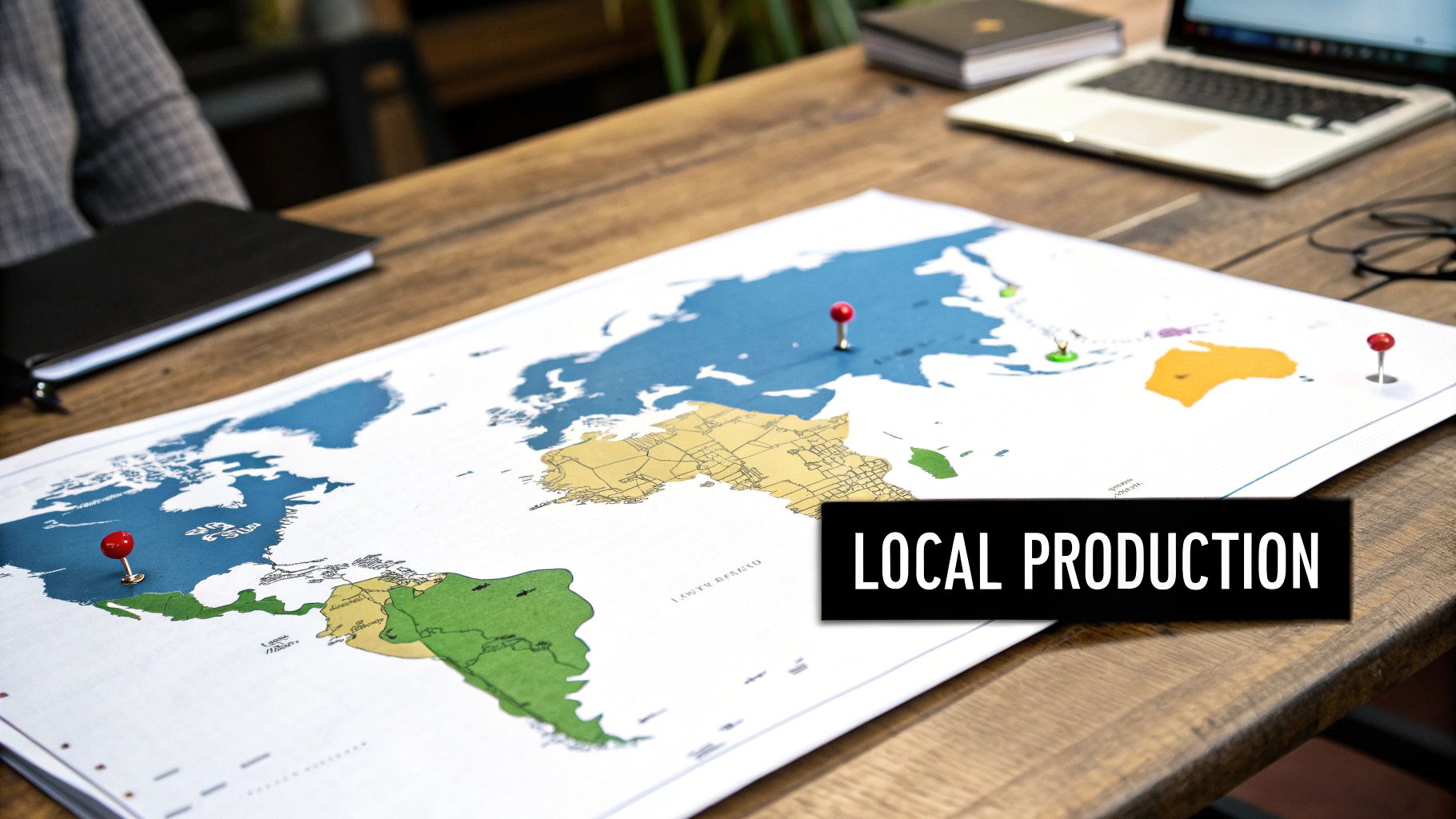Explore key supply chain resilience strategies to safeguard your business. Learn proven methods to enhance flexibility and reduce risks today.

In today's volatile global market, an efficient supply chain isn't enough; it needs to be unbreakable. From geopolitical shifts to unexpected weather events, disruptions are no longer the exception but the norm. The critical difference between companies that falter and those that flourish lies in their ability to anticipate, absorb, and adapt to these shocks. This is where building a robust, agile network becomes a non-negotiable part of your business strategy.
This guide moves beyond theory to provide seven proven supply chain resilience strategies that you can implement to not only survive disruptions but also gain a powerful competitive edge. Think of this not as a collection of ideas, but as an actionable blueprint for creating a supply chain that bends without breaking. We'll explore practical steps for diversifying suppliers, optimizing inventory, enhancing visibility, and more.
Whether your freight is moving across the state or across the country, a resilient plan ensures it gets there on time, every time. Let’s explore how you can fortify your operations, from the first mile to the last.
Putting all your eggs in one basket is risky business, especially in the world of supply chains. Supplier diversification and multi-sourcing is the strategy of intentionally sourcing materials, components, or services from several suppliers instead of just one. This approach fundamentally reduces your dependency on a single source, creating a safety net of alternative supply channels that you can activate when your primary partners face disruptions. It’s one of the most foundational supply chain resilience strategies you can implement.
This tactic transforms a dangerous single point of failure into a flexible, resilient network. If a natural disaster hits your main supplier's region, a geopolitical issue arises, or they simply go out of business, you aren't left scrambling. Instead, you can pivot to your secondary or tertiary suppliers, keeping production lines humming and customer orders fulfilled without missing a beat.

The core benefit of multi-sourcing is risk mitigation. Beyond just avoiding shutdowns, it also gives you leverage in negotiations and protects you from sudden price hikes. For instance, Apple famously maintains multiple suppliers for critical iPhone components like screens and memory chips, often sourcing from competitors like Samsung and LG. This ensures a steady supply and fosters competitive pricing.
Here’s how you can put this strategy into action:
Building a diverse supplier network requires upfront effort, but the security it provides is invaluable. It’s a proactive step that strengthens your supply chain from the ground up, ensuring your freight keeps moving no matter the obstacle.
Holding onto "just-in-case" inventory might seem like a relic of the past, but when done smartly, it’s a powerful defense against disruption. Strategic inventory buffering is a calculated approach to holding extra stock (safety stock) to cushion your operations against unexpected spikes in demand or delays in supply. This isn't about hoarding inventory; it's about using data to maintain the optimal amount, ensuring you can meet customer needs without tying up excessive capital.
This tactic acts as a shock absorber for your supply chain. When a supplier's shipment is delayed by a week or a sudden trend causes demand to surge, your safety stock fills the gap. This prevents stockouts, keeps customers happy, and allows your production to continue smoothly, making it one of the most effective supply chain resilience strategies for managing variability.

The primary benefit of strategic inventory buffering is continuity. It ensures you can fulfill orders even when the unexpected happens, protecting revenue and brand reputation. For example, pharmaceutical companies must maintain significant safety stocks of critical medicines to handle public health emergencies, ensuring availability regardless of production or shipping disruptions. Similarly, Zara keeps strategic inventory of raw fabrics, allowing it to rapidly respond to fast-fashion trends.
Here’s how you can put this strategy into action:
Investing in the right amount of safety stock is a direct investment in customer satisfaction and operational stability. It’s a proactive measure that keeps your business running when the supply chain throws you a curveball.
You can't manage what you can't see. In a complex global network, flying blind is a recipe for disaster. Supply chain visibility and real-time monitoring involve using technology to gain a complete, end-to-end view of your products, materials, and information as they move from your suppliers to your end customers. This strategy is a cornerstone of modern supply chain resilience strategies, transforming reactive problem-solving into proactive disruption management.
By leveraging tools like IoT sensors, GPS tracking, and advanced analytics, you can track shipments, monitor inventory levels, and get instant alerts about delays or issues. This transparency allows you to anticipate problems before they escalate, make faster, more informed decisions, and communicate accurate timelines to your customers, significantly reducing the impact of unforeseen events.

The power of real-time visibility lies in its ability to provide actionable intelligence. Instead of waiting days for an update on a delayed shipment, you know the moment it happens and can immediately pivot to a backup plan. For instance, Unilever uses a network of "control towers" that consolidate data from across its global operations. This provides a single source of truth, allowing them to spot potential bottlenecks and reroute shipments to avoid costly delays.
Here’s how you can put this strategy into action:
By illuminating every corner of your supply chain, you replace uncertainty with control. This level of oversight empowers you to build a truly agile and resilient operation, ready to navigate any challenge that comes its way.
Relying on a single, far-flung region for your production or sourcing is a recipe for disruption. Geographic distribution and nearshoring is the strategy of spreading your operational footprint across different locations and bringing parts of your supply chain closer to home. This tactic reduces your exposure to localized risks like natural disasters, political instability, or port shutdowns and shortens lead times, making your entire network more agile. It's a powerful component of modern supply chain resilience strategies.
This approach moves beyond simply having multiple suppliers to having them in multiple, strategically chosen places. If a trade dispute impacts one country or a hurricane shuts down a key port, you're not paralyzed. Instead, you can ramp up operations in another region or rely on your nearshored facilities to keep goods flowing to your customers, effectively insulating your business from a single point of geographic failure.

The key benefit here is a dramatic reduction in risk and transit time. Shorter distances mean less vulnerability to shipping container shortages or ocean freight delays. For example, automakers like Ford have established production hubs in Mexico to serve the North American market. This nearshoring move allows them to respond faster to regional demand and sidestep many of the logistical hurdles associated with trans-pacific shipping.
Here’s how you can put this strategy into action:
Geographic diversification is a strategic investment in stability. By placing operations closer to your end customers, you gain control and speed, ensuring your freight is less susceptible to global shocks.
Moving beyond simple transactional relationships with your suppliers can unlock a powerful new level of stability. Collaborative partnerships and supplier integration involve building deep, strategic alliances with key partners. This strategy is about treating your suppliers less like vendors and more like extensions of your own team, involving them in joint planning, risk management, and even innovation. This transforms your supply chain from a series of individual links into a cohesive, interconnected ecosystem.
This deep integration means that when a disruption hits, you aren't just sending out a purchase order and hoping for the best. Instead, you're working hand-in-hand with a trusted partner who understands your business inside and out. They are more invested in your success and more willing to go the extra mile to find solutions, share information, and adapt to unforeseen challenges, making it one of the most effective supply chain resilience strategies.
The primary benefit of this strategy is the shared intelligence and mutual investment it creates. By aligning goals and sharing data, both parties can anticipate problems and respond faster. For example, Tesla's close integration with its battery supplier, Panasonic, has been critical. This partnership involves co-locating facilities and joint R&D, allowing them to innovate quickly and navigate supply shortages together, ensuring production continuity for Tesla’s vehicles.
Here’s how you can put this strategy into action:
Building these deep relationships takes time and resources, but the payoff in stability, innovation, and responsiveness is immense. It fortifies your supply chain against disruptions by ensuring your most critical partners are fully aligned with your success.
In a world of constant change, rigidity is a liability. Agile manufacturing and flexible production systems are designed to build adaptability directly into your operations, allowing you to quickly pivot in response to shifting demand, supply disruptions, or new market opportunities. This approach moves away from static, high-volume production lines and toward systems that can be rapidly reconfigured. It's one of the most dynamic supply chain resilience strategies for staying competitive.
This strategy transforms your production floor from a fixed asset into a responsive tool. When a key component becomes unavailable or a sudden trend creates a surge in demand for a different product, a flexible system can adapt without a complete overhaul. This agility ensures you can continue to meet customer needs and capitalize on opportunities, rather than being paralyzed by unexpected events.
The primary benefit of agile manufacturing is its ability to reduce lead times and respond to market volatility with incredible speed. It allows businesses to thrive on change rather than just survive it. For example, Zara's famous "fast fashion" model relies on a highly flexible production system that can take a new design from concept to store shelf in just a few weeks. Similarly, automotive plants are now designed to produce multiple vehicle models on the same assembly line, allowing them to adjust output based on real-time sales data.
Here’s how you can put this strategy into action:
Adopting agile manufacturing is a forward-thinking investment in resilience. It ensures your operations can bend without breaking, keeping your freight moving and your business ahead of the curve. To learn more about modern operational efficiencies, explore these supply chain management best practices.
You can't prepare for a storm if you don't check the weather forecast. Risk assessment and scenario planning is the strategic equivalent for your supply chain: a systematic process of identifying potential threats, analyzing their likely impact, and creating detailed contingency plans before a crisis ever hits. This proactive approach moves you from a reactive, damage-control mindset to one of prepared readiness. It’s a cornerstone of any robust set of supply chain resilience strategies.
This method involves asking a series of "what if" questions and building practical playbooks for each answer. What if a key port shuts down? What if a cyberattack cripples our logistics partner? By gaming out these scenarios, you can develop and test response plans, ensuring your team knows exactly what to do when a disruption occurs. It turns uncertainty into a manageable set of prepared actions.
The power of this strategy lies in its ability to build "muscle memory" for crisis response. By practicing for disruptions, you reduce panic and decision-making time when it matters most. For example, pharmaceutical companies used pandemic scenario planning long before 2020 to ensure they could maintain the supply of critical medicines. Similarly, food companies often model scenarios around extreme weather events to protect their perishable supply chains.
Here’s how you can put this strategy into action:
Anticipating potential failures is not pessimistic; it's smart business. This forward-looking strategy ensures that when a disruption does occur, you're executing a well-rehearsed plan, not improvising in a crisis.
We've explored seven powerful supply chain resilience strategies, moving from high-level concepts to tangible actions you can implement. From diversifying your supplier base and optimizing safety stock to embracing real-time visibility and nearshoring, each strategy acts as a critical layer of defense against the inevitable disruptions of the modern world. The journey isn't about creating an unbreakable chain; it's about building a flexible, intelligent, and responsive network that can bend without breaking.
The core takeaway is that resilience is no longer a "nice-to-have" or a back-burner project. It has become a fundamental competitive advantage. By weaving these strategies together, you’re not just preparing for the next crisis. You are building a more robust, efficient, and customer-centric operation that can thrive in times of both stability and volatility. Remember, the goal is proactive adaptation, not reactive panic.
Viewing these strategies as interconnected is key. Enhanced visibility (Strategy #3) makes supplier diversification (Strategy #1) more manageable. Agile manufacturing (Strategy #6) is supercharged by strong collaborative partnerships (Strategy #5). No single tactic works in a vacuum. Your immediate task is to identify which of these strategies will deliver the most significant impact on your unique vulnerabilities.
Here’s a simple action plan to get started:
An agile logistics backbone is the final, essential piece of the resilience puzzle. Having the ability to pivot your shipping plans on a dime, secure capacity on difficult lanes, and get transparent pricing is what turns a good plan into a great one. Don't let freight be the point of failure when your entire strategy depends on it.
Need to move a shipment right now? See how fast and easy it can be.
Ready to build a more resilient logistics network? FreightQuotesNow provides instant access to a marketplace of over 50,000 vetted carriers, giving you the power to find FTL and LTL capacity when you need it most. Stop scrambling for quotes and start building a flexible shipping strategy today at FreightQuotesNow.